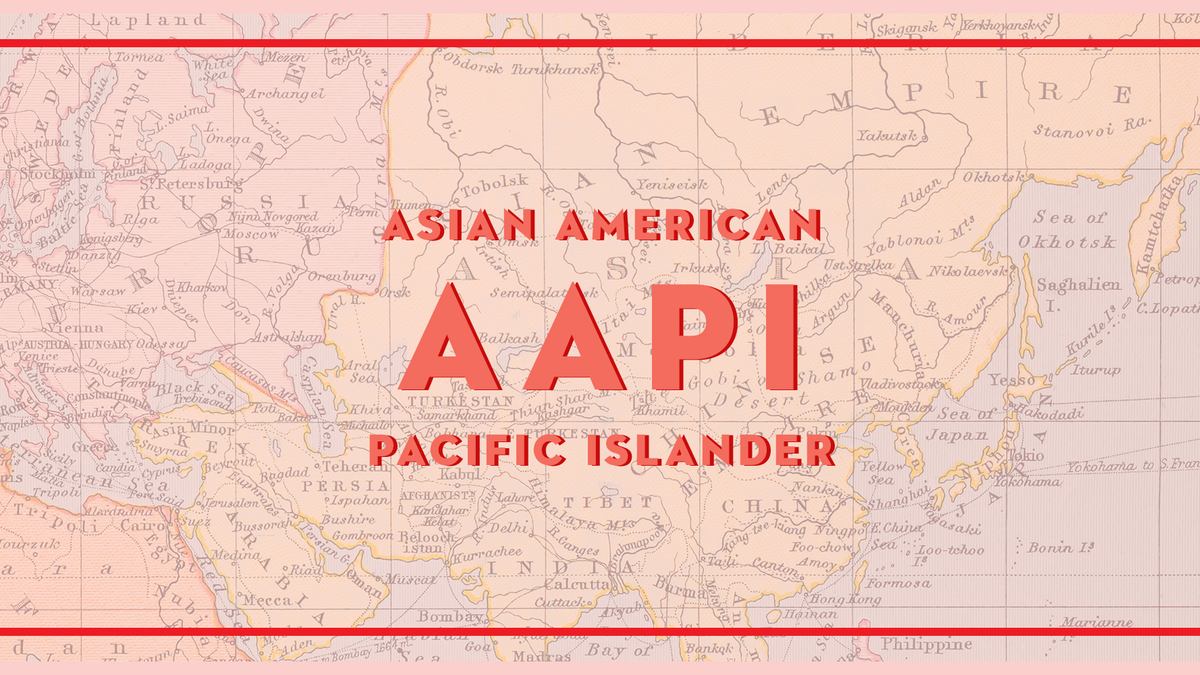Asian American and Pacific Islander, or AAPI, is an umbrella term that refers to a vast, diverse group of people from a collection of countries in the Asia-Pacific region. The label is primarily a geographic one and includes people with “Asian, Asian American or Pacific Islander ancestry, who trace their origins to the countries, states and communities of these regions,” according to the Asian Pacific Institute. More than 100 languages and nearly 50 ethnic groups are represented from East and Southeast Asia, the Indian subcontinent and the Pacific Islands and their diasporas.
AAPI is a term widely used today by the media and cultural and political organizations. And while a catch-all term can be helpful for community organizing and advocacy, some have argued that AAPI privileges East Asians, such as those from China, Japan and Korea, erasing the identities of cultural groups such as South Asians and Native Hawaiians. Further, aggregating the data of Asians and Pacific Islanders together can obscure the significant economic, educational, and health disparities across the groups.
The Asian Pacific Institute writes, “There are conflicting views on the appropriateness of any aggregate classification or reference…while our communities use various names to describe themselves, these groupings are ultimately political and part of a dynamic, continuing process of self-determination and self-identification.”
It is also important to keep in mind that categories like Asian American and Pacific Islander— along with other racial and ethnic terms like white, Black, Hispanic or Latino — are classifications used by the government in the U.S. Census.
In this article, we’ll go through a brief history of the term AAPI and explain how it is being currently used as a geographical and cultural reference point.
Understand the meaning of AAPI
Dawn Lee Tu, Ph.D, faculty director at De Anza College and former director of Asian Pacific American student development at UC Berkeley, explains that the term "Asian American" was first coined by student activists in 1968 to replace the outdated and derogatory term "oriental" to refer to Asians in the United States.
Under the U.S. Census Bureau, that term officially evolved to "Asian Pacific Islander" in the 1980s and early 90s. In 1997, the White House Office of Management and Budget split the terms "Asian" and "Pacific Islander" into two separate categories.
“AAPI is meant to be an inclusive term to define the umbrella group of people who can trace their roots to the continent of Asia or the island nations of the continent of Oceania. Currently, it is the term that is used most to describe this group,” says Kevin Nadal, Ph.D., the author of Filipino American Psychology and a professor at the City University of New York who researches multicultural issues in psychology and education.
He says that the term used to describe the vast and multifaceted group has continuously changed and shifted to accommodate and respect various identities. “Previously, it was common for people to use Asian American only, which excluded Pacific Islander experiences. Some people have used Asian Pacific American, but many Pacific Islanders disliked this term because they didn’t consider themselves American, especially for those residing outside the continental United States,” says Nadal.
Remember that language designed to encompass such a large cultural group has its limitations, and terminology has shifted over time based on changing sociocultural conditions and shifting identity politics. One way to show respect to someone with AAPI heritage is to listen to the language they use to describe their personal cultural identity.
Who is included in the Pacific Islander category?
The Pacific Islands are island nations in the Pacific Ocean that are located in the geographic region called Oceania. It helps to look at Pacific Islander countries' geographic location. Pacific Islanders are people whose heritage is connected to origins belonging to one or more of the 15 nations included in the census, which are divided into the subregions of Polynesia, Micronesia and Melanesia. This classification includes, but is not limited to, people from Samoa, Tahiti, Guam, Fiji and Papua New Guinean.
Native Hawaiians are Pacific Islanders from the islands of Polynesia. “The U.S. federal government has used the term AANHPI (Asian American, Native Hawaiian, and Pacific Islander) to make overt intentions to include Native Hawaiians and to center their experiences, especially in response to the U.S. colonizing their native land and making it a state,” says Nadal. “However, when using AAPI, it is presumed that Native Hawaiians would be included.”
In addition, the U.S. Census categorizes indigenous Australians, also known as the Australian Aboriginal Peoples, as Pacific Islanders. However, it is widely believed that this group originally traveled from Asia via land bridges between the two continents thousands of years ago. Interestingly, the Austronesian languages, a large language family that can be found in many countries in Melanesia, includes those spoken throughout the Philippines, Madagascar and Malaysia, and even includes languages spoken in some parts of Taiwan, Cambodia, Laos, and Vietnam.
Who is included in the Asian category?
Today, the U.S. Census Bureau classifies Asians as "having origins in any of the original peoples of the Far East, Southeast Asia or the Indian subcontinent," including, but not limited to Korea, China, Japan, Thailand, Malaysia, India, Singapore, Cambodia, Vietnam and the Philippines.
While Filipinos are Southeast Asian, some have aligned historically with the term “Pacific Islander” more than “Asian.” Nadal explains, “When the Asian American umbrella identity was first used in the 1960s, many Filipinos felt excluded because most associated ‘Asian’ with ‘East Asian,’ like Chinese, Japanese, Korean, etc. As a result, many Filipinos formed alliances with Pacific Islander groups who felt similar sentiments about the Asian American umbrella. Some Filipinos might identify with the term ‘Pacific Islander’ to protest the lack of inclusion in the Asian American umbrella. However, they are still considered Asian. Some Filipinos have connected to the term ‘Brown Asian’ to connote that their experiences as Asian Americans are influenced by their skin color.”
In addition, there are many global Asian diasporic communities that include different languages, religions and cultures. For example, people from Central Asia — which includes countries like Kazakhstan, Kyrgyz Republic, Tajikistan, Turkmenistan and Uzbekistan—may or may not identify as Asian due to their geographic proximity to Europe.
People from West Asia, also known as Southwest Asia and part of the Middle East — which includes countries like Armenia, Azerbaijan, Bahrain, Cyprus, Georgia, Iraq, Israel, Jordan, Kuwait, Lebanon, Oman, Palestine, Qatar, Saudi Arabia, Syria, Turkey, United Arab Emirates and Yemen, some of which are included as nations of the Arab League — may or may not also identify as Asian.
It is critical to keep in mind that cultural and ethnic identities are complex, intersecting and constantly in flux.
Glossary of AAPI countries and geographic labels
Countries that are included in the AAPI umbrella include those in the brief reference glossary below, which will help you organize geographical terms related to Asian and Pacific Islander identities. Keep in mind that this list is a simplification and that cultural identities often overlap.
- AAPI: Asian American and Pacific Islander. This term generally includes all people of Asian, Asian American or Pacific Islander descent.
- Asian: A person having origins in any of the original peoples of East Asia,, Southeast Asia or the Indian subcontinent.
- East Asian: A person of Korean, Chinese, Taiwanese, Hong Kong, Japanese or Mongolian descent.
- South Asian: A person of Indian, Bangladeshi, Sri Lankan, Nepal, Pakistani, Maldivian, Iranian, Bhutanese or Afghani heritage.
- Southeast Asian: A person of Filipino, Cambodian, Vietnamese, Laotian, Indonesian, Burmese, Malaysian, Thai or Singaporean descent.
- Central Asian: A person with origins in the original peoples of Kazakhstan, Kyrgyz Republic, Tajikistan, Turkmenistan, Uzbekistan and Tibet.
- Pacific Islander: A person with origins in the original peoples of Polynesia, Micronesia and Melanesia, including Carolinian, Chamorro, Chuukese, Fijian, Guamanian, Hawaiian, Kosraean, Marshallese, Native Hawaiian, Niuean, Palauan, Papua New Guinean, Pohnpeian, Samoan, Tokelauan, Tongan, Yapese.
- West Asian: A person with heritage from the original peoples of Armenia, Azerbaijan, Bahrain, Cyprus, Georgia, Iraq, Israel, Jordan, Kuwait, Lebanon, Oman, Palestine, Qatar, Saudi Arabia, Syria, Turkey, United Arab Emirates and Yemen.












